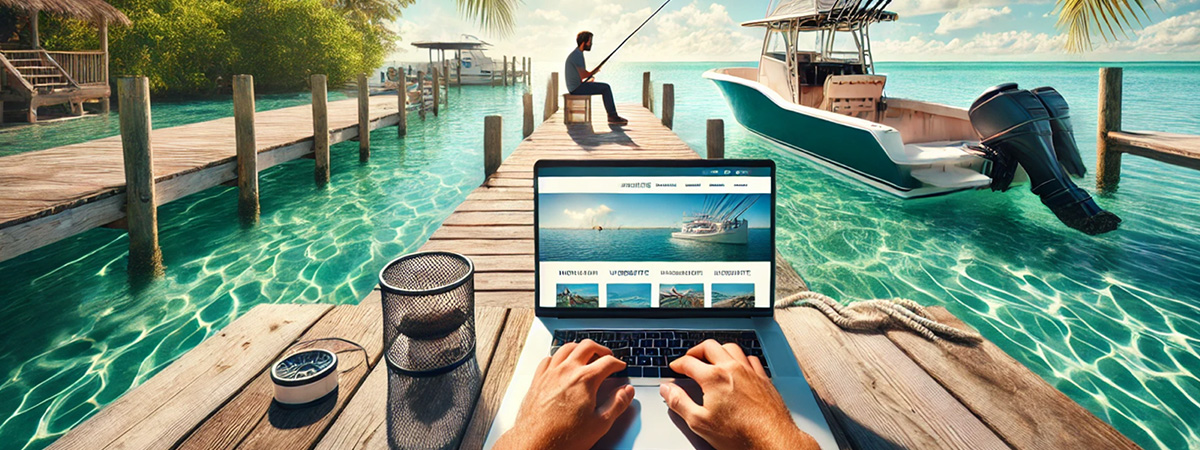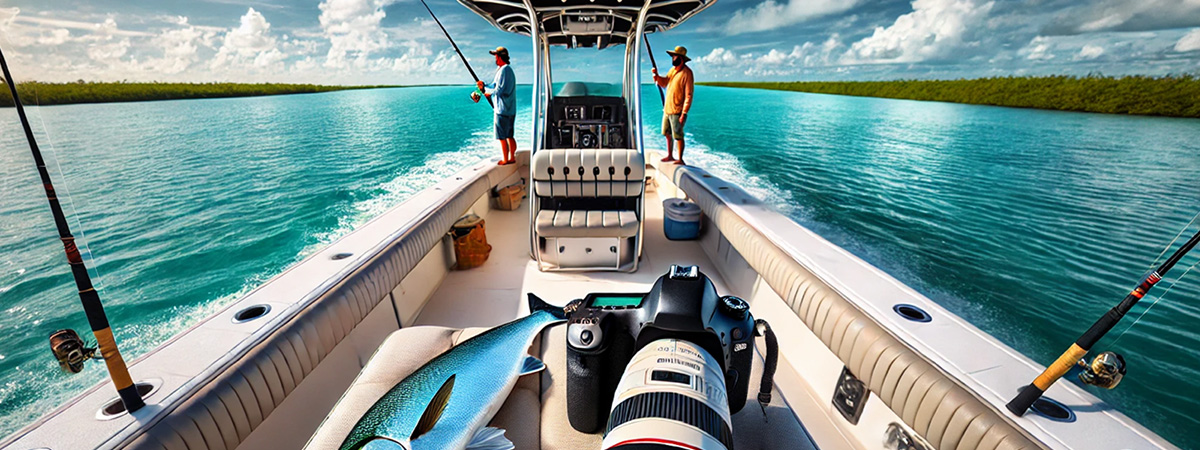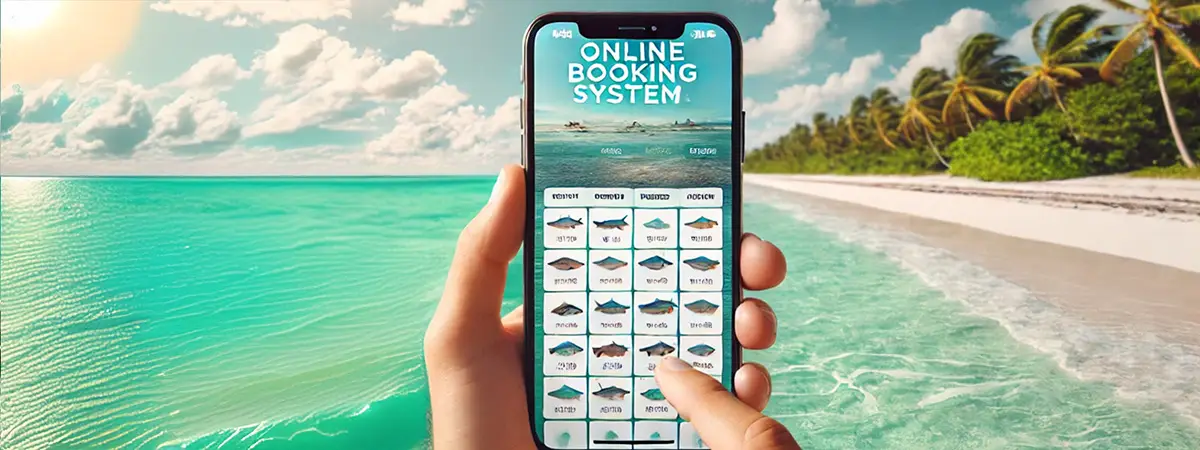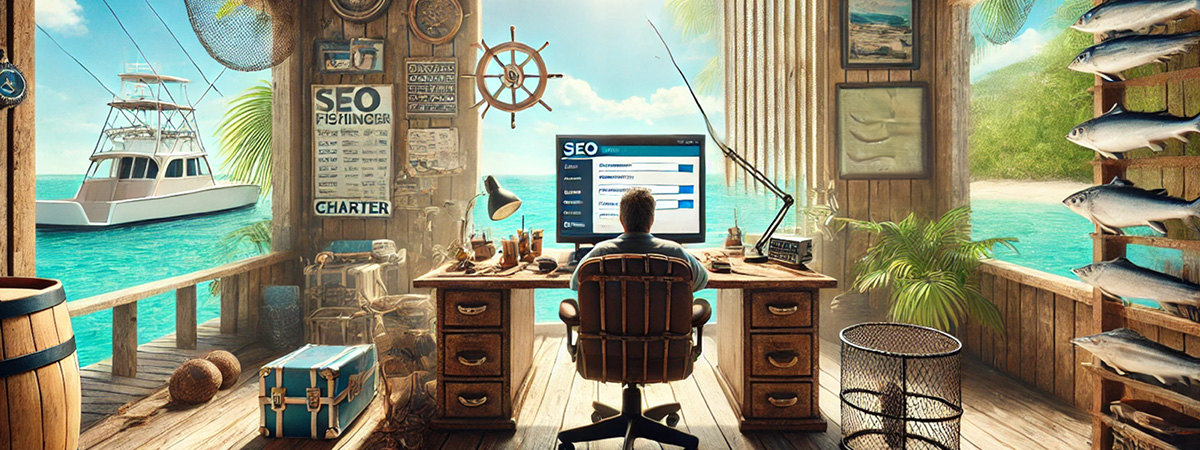Your website is the first impression most anglers get of your charter business — and just like a clean boat and friendly smile, a well-built website helps turn visitors into paying customers. Whether you’re a seasoned captain or just starting out, your website needs to do more than just look good. It has to make it easy for anglers to find you, learn about your trips, and book their spot — fast.
At Thrive Creative Labs, we’ve been building fishing charter websites for years, and we’ve seen what works (and what doesn’t). To help you navigate the process, we’ve put together this checklist of 20 must-have features that every successful charter website needs. Whether you’re considering a full redesign or just want to improve your existing site, these features will make sure your website is working as hard as you do.
1. Clear, Modern Design Built for Every Device

First impressions matter — especially online. When anglers visit your website, they decide in just a few seconds whether you’re a professional guide they want to book with, or if they should keep looking. A clean, modern design that’s easy to navigate and works seamlessly on desktops, tablets, and phones is essential.
While many potential customers will visit your site from their phones, especially when they’re already in your area, plenty of anglers still research and plan trips from their laptops or desktops. That’s why it’s important to have a website that looks great and functions perfectly across all screen sizes, not just mobile.
Cluttered, outdated designs — whether on desktop or mobile — don’t just look bad, they cost you bookings. A streamlined design that highlights your trips, your expertise, and why anglers should fish with you will always perform better than a website trying to cram everything onto the homepage.
2. Strong Hero Section with Clear Value Proposition
The top section of your homepage — often called the hero section — is the very first thing visitors see. It’s your chance to hook them right away. This section should feature a high-quality, authentic photo or video that captures the excitement of fishing with you, paired with a clear, simple message explaining who you are, what you offer, and why anglers should book with you.
Keep the text short and punchy. Something like:
“Unforgettable Inshore & Offshore Fishing Charters in [Location] — Book Your Trip Today!”
Most importantly, your hero section must include a clear, attention-grabbing “Book Now” button — and it should be visible without scrolling, especially on mobile. The easier you make it for visitors to take action, the more bookings you’ll land.
3. Simple, Intuitive Navigation
When anglers visit your website, they should be able to find exactly what they’re looking for — fast. A simple, well-organized navigation menu helps them do just that. If visitors have to dig through confusing menus or hunt for basic information, they’ll move on to another guide.
Your main navigation should include only the most important pages, such as:
- Home
- Charters (or Trips)
- About the Captain
- Reviews
- Photo Gallery
- Contact
It’s also critical that your “Book Now” button is always visible, especially on desktop — the top-right corner is a natural spot where visitors expect to see it.
A clean, focused navigation not only makes your site easier to use, but it also helps search engines understand your site structure, which is good for SEO. In short, the easier it is for visitors to find what they need, the more likely they are to book a trip.
4. Detailed Charter Descriptions
Anglers want to know exactly what to expect before they book a trip. That’s why every fishing charter website should have individual pages for each type of trip you offer, with clear, detailed descriptions.
Each page should cover the essentials, including:
- Trip length and start times
- Target species
- Pricing — including any deposit requirements
- What’s included (gear, bait, licenses, etc.)
- What guests should bring
- Who the trip is best suited for (families, beginners, experienced anglers, etc.)
Not only does this level of detail help potential customers feel confident about booking, but it also helps boost your website’s SEO. Search engines love clear, informative pages that directly answer the questions people are searching for — like “4-hour inshore fishing trip in Key West.”
In short, the more detailed and helpful your charter descriptions are, the more likely anglers are to book — and the easier it is for Google to match your site with the right searchers.
5. High-Quality Photos & Videos

Great photos and videos don’t just make your website look good — they help anglers picture themselves on your boat, reeling in the fish of a lifetime. Whether they’re scrolling on their phone or planning a trip on their laptop, the right images can make the difference between booking with you or moving on to the next guide.
Every fishing charter website should feature real, high-quality photos of your boat, your customers, and the fish they’ve caught. Authenticity matters — stock photos won’t cut it with today’s savvy anglers.
In addition to photos, consider adding short videos. A quick video tour of your boat or a 60-second highlight reel from a recent trip can go a long way in building excitement and trust.
Remember: your photos and videos don’t have to be professionally shot, but they do need to be clear, bright, and capture the real experience you offer.
6. Captain Bio & Personal Story
Anglers aren’t just booking a boat — they’re booking you. Your experience, personality, and passion for fishing are all part of what sets your charter apart, so it’s important to share that story on your website.
Your “About the Captain” page should go beyond basic credentials. Sure, mention your years of experience and any certifications, but also tell your story. What made you fall in love with fishing? What do you love most about guiding? Why do you love this particular fishery?
Adding a few personal touches — like a story about your first big catch or how you got started guiding — helps potential customers feel like they already know you. It’s also a great place to share photos of you in action, with clients, or even with your family if they’re part of the business.
A strong, personal bio helps build trust and makes your charter feel like the right fit for anglers looking for more than just a boat ride.
7. Easy-to-Find Contact Info
When a potential customer is ready to book — or just wants to ask a quick question — they shouldn’t have to hunt for your contact information. The best fishing charter websites make it incredibly easy to get in touch, no matter what page a visitor is on.
At a minimum, your phone number should be prominently displayed in the header of your site, especially on desktop. Many guides also include a simple contact form in the footer or on a dedicated contact page. Bonus points for adding a click-to-call button on mobile, so anglers can call you with a single tap.
The easier you make it for someone to reach out, the more likely they are to actually do it — and that’s how more bookings happen.
8. Online Booking System

Today’s anglers expect the convenience of being able to book a trip online, without needing to make a phone call or send an email. Having a simple, reliable online booking system makes it easier for customers to reserve their trip — and easier for you to manage your calendar.
Your booking system should:
- Clearly show available dates and trip options
- Allow customers to book and pay a deposit online
- Send automatic confirmation emails
- Be easy to use on desktop, tablet, and mobile devices
Whether you use a dedicated charter booking platform or a custom solution, the key is making the process frictionless. The easier it is to book, the more trips you’ll fill.
9. Trip Reports & Fishing Reports (Updated Regularly)
Regularly publishing trip reports or fishing reports is one of the smartest ways to keep your website fresh and drive more traffic from search engines. Anglers love reading about what’s biting, where you’ve been fishing, and the techniques that are working — especially when they’re planning their own trip.
These reports don’t have to be long — a few photos and a quick recap of recent trips is all it takes. The key is to update them regularly and make them personal. Share your excitement, brag on your customers, and give potential clients a taste of what they can expect when they book with you.
There’s also a powerful SEO benefit to posting regular reports. Every new report gives Google more content to crawl, especially if you’re including local keywords like species names, locations, and trip types. Over time, this content helps your website rank better for searches like “[Location] fishing reports” or “inshore fishing near [Location].”
Whether you call them fishing reports, trip recaps, or just a captain’s log, keeping them fresh pays off.
10. Reviews & Testimonials (with Photos!)
Before booking a trip, most anglers want to know what other people have to say about fishing with you. That’s why including real customer reviews and testimonials on your website is so important. Positive feedback helps build trust and gives potential clients confidence that they’re making the right choice.
Don’t just copy and paste a few sentences — bring your reviews to life by pairing them with photos of happy clients holding their catch. Real photos from actual trips go a long way in proving the authenticity of your reviews.
It’s also smart to link directly to your Google or Facebook reviews, so visitors can see even more feedback if they want to. Just make sure your reviews are recent and relevant — if the last review on your website is from 2018, that’s a red flag.
Fresh, authentic reviews (especially with photos) are one of the most powerful tools you have to turn visitors into bookings.
11. Social Media Links (But Don’t Rely on Them)
Social media is a valuable tool for any fishing charter, but it should always be a secondary tool — not your main platform. Your website is the one place where you control the content, the message, and the booking process. Social platforms come and go (and algorithms change constantly), but your website is your home base.
That said, anglers do like to check out your recent catches, so links to your Facebook and Instagram pages should be easy to find — usually in your website footer. This lets visitors explore your social channels without leaving your site entirely.
The key is balance: use social media to drive traffic back to your website, where anglers can get all the details and book a trip. Never make the mistake of thinking your Facebook page can replace a well-built website.
12. FAQ Page
Your potential customers have questions — and if you answer them up front, you’ll build trust and save yourself time answering the same calls and emails over and over again. That’s why every fishing charter website should include a Frequently Asked Questions (FAQ) page.
Good FAQ pages cover the most common topics, including:
- What to bring on the trip
- How deposits and cancellations work
- Whether kids are welcome
- If they need a fishing license
- What happens if the weather is bad
A clear, helpful FAQ page not only makes customers feel more comfortable booking, but it also helps your website rank for searches like “what to bring on a fishing charter in [location]”.
As a bonus, updating your FAQ page over time based on the actual questions you get from customers is an easy way to keep your site content fresh.
13. SEO-Optimized Page Titles, Meta Descriptions & H1s

Most fishing guides don’t think about SEO — but it’s a huge factor in how potential customers find your website. Every page on your site should have a clear, SEO-friendly title and meta description, along with a well-structured H1 heading that tells search engines (and visitors) exactly what the page is about.
For example, instead of a page title like “Our Charters,” it’s better to use something like “Inshore & Offshore Fishing Charters in Key West.” This not only helps your SEO but also tells visitors they’re in the right place.
Good SEO doesn’t happen by accident — it’s built into your website from the ground up.
14. Fast Loading Speed
Site speed isn’t just an SEO factor — it’s critical for user experience. If your website takes too long to load, visitors (especially on mobile) will leave before they ever see your content.
Fast-loading sites are especially important for charters because potential customers might be on slower mobile networks while traveling. Optimizing images, streamlining code, and using fast, reliable hosting all help ensure your site loads quickly on every device.
15. Clear Pricing (No Hidden Fees)
Anglers want to know exactly what a trip will cost — and what’s included — before they book. Make sure your website clearly lists pricing for all trip options, including any deposits required, what’s included, and any potential add-ons or optional charges.
Being transparent with pricing not only builds trust, it also reduces back-and-forth communication and helps you avoid awkward conversations with customers later.
16. Google Maps Integration (Location Matters)
Most anglers looking for a charter are searching based on location — and they want to know exactly where you’re located and where they’ll meet you on the day of the trip. That’s why it’s smart to embed a Google Map directly on your contact page or footer.
Maps also help with local SEO, especially if they’re tied to your Google Business Profile. The easier you make it for customers to find you, the smoother the booking process becomes.
17. About the Boat & Gear

For many anglers, the boat and gear are a big part of the decision. They want to know what kind of vessel they’ll be fishing from, how much space there is, and what kind of equipment they’ll be using.
A dedicated page that highlights your boat (with photos) and lists the gear you provide — rods, reels, electronics, safety gear — helps build excitement and confidence. If you run a high-end boat or specialize in specific techniques, this page is your chance to showcase that.
18. Highlight Family-Friendly or Specialty Trips
Not every charter customer is a hardcore angler. Many visitors are families, first-timers, or vacationers looking for a fun experience. If you offer trips tailored to kids, beginners, or certain groups, make sure those options are easy to find and clearly described on your site.
Highlighting your patience, teaching skills, and family-friendly approach helps set the right expectations and can make your charter stand out to vacationers.
19. Email List Signup (for Fishing Reports & Specials)
Every fishing charter website should have an option for visitors to subscribe to your email list. It’s one of the easiest ways to stay in touch with past customers, promote seasonal specials, and share your latest fishing reports.
Make your signup form simple — just a name and email address. Offer a little incentive if needed, like “Sign up to get my monthly fishing reports and special offers.” Over time, your email list becomes a powerful tool for repeat bookings and referrals.
20. SSL Certificate & Basic Security
It might not be flashy, but website security matters — to both your customers and search engines. Every charter website should have an SSL certificate, which encrypts information sent through your site (like contact forms or booking details) and displays the secure padlock icon in the browser bar.
Google also gives preference to secure sites in search rankings, so having an SSL is good for SEO and trust. If visitors see a “Not Secure” warning, there’s a good chance they’ll leave before ever booking a trip.
Wrapping It All Up
Whether you’re building a brand new website or updating an old one, making sure these 20 features are in place will give you the best shot at turning visitors into bookings. Your website is your most important marketing tool — make sure it’s working as hard as you do.
Need help building or improving your fishing charter website? Reach out to Thrive Creative Labs — we specialize in websites and marketing built specifically for fishing guides and charter businesses.